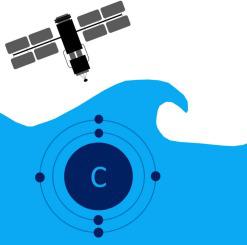Earth-Science Reviews ( IF 12.1 ) Pub Date : 2023-03-18 , DOI: 10.1016/j.earscirev.2023.104386 Robert J.W. Brewin , Shubha Sathyendranath , Gemma Kulk , Marie-Hélène Rio , Javier A. Concha , Thomas G. Bell , Astrid Bracher , Cédric Fichot , Thomas L. Frölicher , Martí Galí , Dennis Arthur Hansell , Tihomir S. Kostadinov , Catherine Mitchell , Aimee Renee Neeley , Emanuele Organelli , Katherine Richardson , Cécile Rousseaux , Fang Shen , Dariusz Stramski , Maria Tzortziou , Andrew J. Watson , Charles Izuma Addey , Marco Bellacicco , Heather Bouman , Dustin Carroll , Ivona Cetinić , Giorgio Dall’Olmo , Robert Frouin , Judith Hauck , Martin Hieronymi , Chuanmin Hu , Valeria Ibello , Bror Jönsson , Christina Eunjin Kong , Žarko Kovač , Marko Laine , Jonathan Lauderdale , Samantha Lavender , Eleni Livanou , Joan Llort , Larisa Lorinczi , Michael Nowicki , Novia Arinda Pradisty , Stella Psarra , Dionysios E. Raitsos , Ana Belén Ruescas , Joellen L. Russell , Joe Salisbury , Richard Sanders , Jamie D. Shutler , Xuerong Sun , Fernando González Taboada , Gavin H. Tilstone , Xinyuan Wei , David K. Woolf

|
The ocean plays a central role in modulating the Earth’s carbon cycle. Monitoring how the ocean carbon cycle is changing is fundamental to managing climate change. Satellite remote sensing is currently our best tool for viewing the ocean surface globally and systematically, at high spatial and temporal resolutions, and the past few decades have seen an exponential growth in studies utilising satellite data for ocean carbon research. Satellite-based observations must be combined with in-situ observations and models, to obtain a comprehensive view of ocean carbon pools and fluxes. To help prioritise future research in this area, a workshop was organised that assembled leading experts working on the topic, from around the world, including remote-sensing scientists, field scientists and modellers, with the goal to articulate a collective view of the current status of ocean carbon research, identify gaps in knowledge, and formulate a scientific roadmap for the next decade, with an emphasis on evaluating where satellite remote sensing may contribute. A total of 449 scientists and stakeholders participated (with balanced gender representation), from North and South America, Europe, Asia, Africa, and Oceania. Sessions targeted both inorganic and organic pools of carbon in the ocean, in both dissolved and particulate form, as well as major fluxes of carbon between reservoirs (e.g., primary production) and at interfaces (e.g., air-sea and land–ocean). Extreme events, blue carbon and carbon budgeting were also key topics discussed. Emerging priorities identified include: expanding the networks and quality of in-situ observations; improved satellite retrievals; improved uncertainty quantification; improved understanding of vertical distributions; integration with models; improved techniques to bridge spatial and temporal scales of the different data sources; and improved fundamental understanding of the ocean carbon cycle, and of the interactions among pools of carbon and light. We also report on priorities for the specific pools and fluxes studied, and highlight issues and concerns that arose during discussions, such as the need to consider the environmental impact of satellites or space activities; the role satellites can play in monitoring ocean carbon dioxide removal approaches; economic valuation of the satellite based information; to consider how satellites can contribute to monitoring cycles of other important climatically-relevant compounds and elements; to promote diversity and inclusivity in ocean carbon research; to bring together communities working on different aspects of planetary carbon; maximising use of international bodies; to follow an open science approach; to explore new and innovative ways to remotely monitor ocean carbon; and to harness quantum computing. Overall, this paper provides a comprehensive scientific roadmap for the next decade on how satellite remote sensing could help monitor the ocean carbon cycle, and its links to the other domains, such as terrestrial and atmosphere.
中文翻译:

来自太空的海洋碳:未来十年的现状和优先事项
海洋在调节地球碳循环方面发挥着核心作用。监测海洋碳循环如何变化是管理气候变化的基础。卫星遥感是目前我们以高空间和时间分辨率全球和系统地观察海洋表面的最佳工具,在过去的几十年里,利用卫星数据进行海洋碳研究的研究呈指数级增长。卫星观测必须与现场相结合观测和模型,以获得对海洋碳库和通量的全面了解。为了帮助确定该领域未来研究的优先顺序,组织了一次研讨会,汇集了来自世界各地从事该主题研究的领先专家,包括遥感科学家、实地科学家和建模人员,目的是阐明对当前状态的集体看法海洋碳研究,找出知识差距,并制定未来十年的科学路线图,重点是评估卫星遥感可能在哪些方面做出贡献。共有来自北美和南美、欧洲、亚洲、非洲和大洋洲的 449 名科学家和利益相关者参与(性别均衡)。会议针对海洋中溶解和颗粒形式的无机和有机碳库,以及储层之间(例如,初级生产)和界面(例如,海气和陆地海洋)之间的主要碳通量。极端事件、蓝碳和碳预算也是讨论的关键话题。确定的新优先事项包括:扩大网络和质量就地观察;改进卫星检索;改进不确定性量化;提高对垂直分布的理解;与模型集成;改进连接不同数据源的空间和时间尺度的技术;并提高了对海洋碳循环以及碳库和光库之间相互作用的基本了解。我们还报告了所研究的特定池和通量的优先级,并强调了讨论期间出现的问题和担忧,例如需要考虑卫星或太空活动对环境的影响;卫星在监测海洋二氧化碳清除方法方面可以发挥的作用;卫星信息的经济估价;考虑卫星如何有助于监测其他重要的与气候相关的化合物和元素的周期;促进海洋碳研究的多样性和包容性;将致力于行星碳不同方面的社区聚集在一起;最大限度地利用国际机构;遵循开放的科学方法;探索远程监测海洋碳的创新方法;并利用量子计算。总的来说,本文为未来十年提供了一个全面的科学路线图,说明卫星遥感如何帮助监测海洋碳循环及其与其他领域(如陆地和大气)的联系。最大限度地利用国际机构;遵循开放的科学方法;探索远程监测海洋碳的创新方法;并利用量子计算。总的来说,本文为未来十年提供了一个全面的科学路线图,说明卫星遥感如何帮助监测海洋碳循环及其与其他领域(如陆地和大气)的联系。最大限度地利用国际机构;遵循开放的科学方法;探索远程监测海洋碳的创新方法;并利用量子计算。总的来说,本文为未来十年提供了一个全面的科学路线图,说明卫星遥感如何帮助监测海洋碳循环及其与其他领域(如陆地和大气)的联系。



























 京公网安备 11010802027423号
京公网安备 11010802027423号